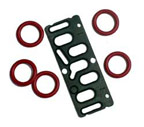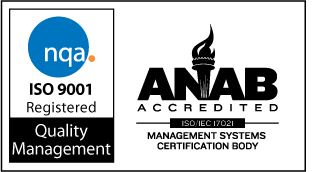
|
7108
S. Alton Way, Unit I |
(303) 758-2728
Home > Tips > Extruded Rubber Seals
|
Tip: Extruded Rubber SealsBackground information: Extruded rubber seals are made by forcing the uncured rubber through a die while it is under heat and pressure. This uncured rubber is then vulcanized, i.e. heated, to cause a chemical reaction which cures the rubber. However, the term "rubber extrusion" is used loosely to refer to many elastomers in addition to natural rubber --- elastomers such as EPDM, EPR, NBR, neoprene, nitrile (Buna-N), silicone, FKM fluorosilicone, Kalrez® and urethane. Extruded rubber seals can be manufactured with a hardness value between 40 and 90 durometers. In addition to o-rings and seals, a rubber extrusion process is used to manufacture rubber components such as tubes, shapes (C, E, H, L, etc.) and forms (rounds, rectangles, trapezoids, etc.). These components are often used in industries such as the chemical, automotive and manufacturing industries without further manufacturing processes applied to the components. However, the extruded components can also be ground, milled, drilled or turned to create other products such as gaskets, seals, caps, motor mounts and suction cups. Extruded rubber o-rings come in both AS568 standard sizes and in custom sizes; we manufacture them in both inch and metric sizes. If you need non-standard extruded rubber seals or o-rings we will need to make a tool made according to the specifications for your application. The accuracy and quality of the tool is critical for the production of quality parts. The tool will be rated in a tolerance class rating system that goes from F1 to F4 for different areas of the tool. A rating of F1 is the highest and means that the area should have a finish up to 10 micro-inches, with no visible tool marks. The lowest rating of F4 means that the area will have a satin like finish. Extruded rubber seals, o-rings and components can have a small amount of flash material which will need to be trimmed. Our name, Problem Solving Products, Inc., really described who we are. For years we have been assisting engineers to design and manufacture custom extruded rubber seals, o-rings and components. We specialize in technical design for new products, solving sealing problems with existing products and engineering products that must operating in extreme environments. We are able to manufacture extruded rubber seals and components both domestically and internationally.
|
On to the tip on low temperature seals.
See our tip on buying natural extruded rubber seals along with a brief history of rubber.
We are located in the Denver Technological
Center in a suburb of Denver, Colorado
©1997-2017, Problem Solving Products, Inc.
Website Map | Privacy Statement
| Terms of Use

